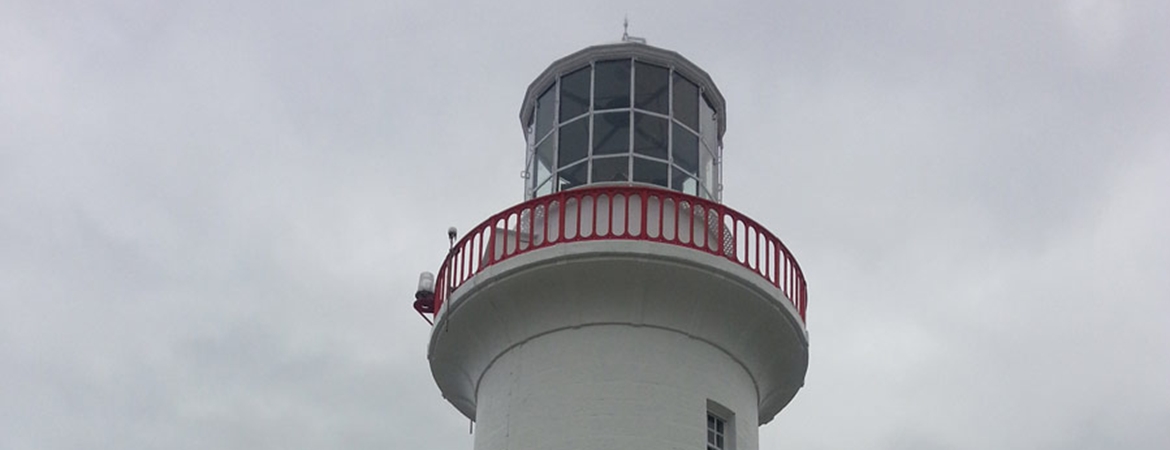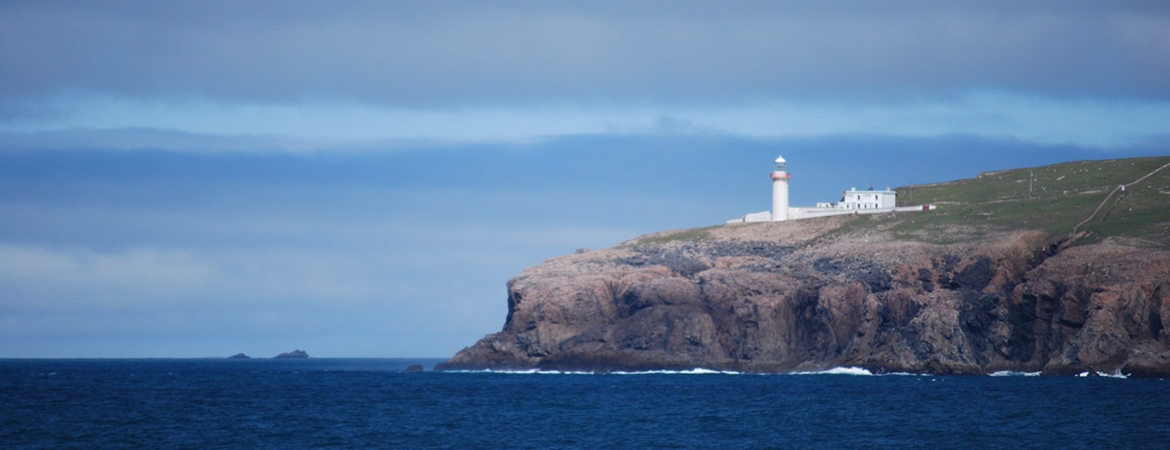The first lighthouse on Aranmore was completed in 1798 by Thomas Rogers on behalf of the Barrack Board. In 1810 the Lighthouse came under the control of the Ballast Board and considerable improvements were made to the light during the period 1817-24.
When the Lighthouse on Tory Island was established in 1832, the light on Aranmore was discontinued, despite protests from mariners using those waters. The protests never subsided, and eventually in 1859, on receipt of numerous memorials from Masters and shipowners, approval was granted for the re-establishment of the Aranmore Light.
A new 23m tower was designed by Mr G. Halpin and constructed by Messrs Daniel Crowe and Sons of Dublin. Masonry from the old tower and dwellings was partly used in the construction of the new station. The cast iron lantern and balcony was supplied by Messrs Edmundsons of Dublin. The second order optic apparatus which had been removed from Rathlin O'Birne in 1864 was used at Aranmore. The light was established on the 1st February 1865 with a character of one flash every minute, with a red sector. The range of the light was 18 miles. Two single story semi-detached dwellings for the two keepers and their families were also constructed.
Not long afterwards, a Captain with Anchor Line Packets, a Glasgow shipping company, pointed out the similarity of character between Aranmore and Skerryvore Lighthouses and the danger that ships might mistake the two.
This was investigated in 1874 and a new light recommended in 1875. Approval was granted by Trinity House and the new light, with a first order optic was installed and lit for the first time on April 1st 1877 with a character flashing alternately white/red every 20 seconds.
A fixed red auxiliary light also was established in 1877 to shine over the Stags Rocks, which lie NE of the Lighthouse. This became a fixed white light in 1904. On 18th April 1932 this fixed white light was altered to an unwatched white light flashing every 3 seconds (Fl 0.33, ec 2.66). The Auxiliary light was altered from flashing white to flashing red on 21st April 1982.
During the period 1924-26 considerable discussion took place about the desirability of a fog signal at Aranmore. Cost estimates for both diaphone and explosive type fog signals were examined. However the Board of Trade decided, in the end of the day, not to sanction the final proposal, which was for an explosive type signal.
A proposal to improve the light in 1927 also did not receive support.
In 1949, improvement of the light was again mooted, and approval was granted in 1950 for conversion of the light to electrical operation with an improved range of 29 miles.
Conversion of the light to electric operation involved the purchase of a new Chance Brothers third order optic with its associated control equipment. The electrical supply was provided by two Lister 10/2 engines driving 100V DC generators. The conversion of the Station to 100V DC operation was completed in 1953. The Auxiliary Light was also converted at that time. The temporary light which had been exhibited for September and October of 1953 was discontinued and on the 1st November 1953 the Main Light was exhibited with its character altered to its present format of 2 white flashes every 20 seconds. On 1st February 1965 the character of the auxiliary light was altered to Fl 3s with a flash duration of 0.75 seconds.
ESB mains electricity became available on Aranmore in the late 1960s and a mains supply was completed to the Lighthouse in 1970. This involved conversion from 100V DC to 220V AC operation and a new mains failure generator set was procured. Conversion of the Lighthouse to automatic operation took place in 1976 and the Keepers were withdrawn on 1st August 1976.
The Attendant lives in the village of Leabgarrow, a distance of 5km from the Lighthouse, and a remote monitoring system keeps him informed of conditions at the Lighthouse.
When the Lighthouse on Tory Island was established in 1832, the light on Aranmore was discontinued, despite protests from mariners using those waters. The protests never subsided, and eventually in 1859, on receipt of numerous memorials from Masters and shipowners, approval was granted for the re-establishment of the Aranmore Light.
A new 23m tower was designed by Mr G. Halpin and constructed by Messrs Daniel Crowe and Sons of Dublin. Masonry from the old tower and dwellings was partly used in the construction of the new station. The cast iron lantern and balcony was supplied by Messrs Edmundsons of Dublin. The second order optic apparatus which had been removed from Rathlin O'Birne in 1864 was used at Aranmore. The light was established on the 1st February 1865 with a character of one flash every minute, with a red sector. The range of the light was 18 miles. Two single story semi-detached dwellings for the two keepers and their families were also constructed.
Not long afterwards, a Captain with Anchor Line Packets, a Glasgow shipping company, pointed out the similarity of character between Aranmore and Skerryvore Lighthouses and the danger that ships might mistake the two.
This was investigated in 1874 and a new light recommended in 1875. Approval was granted by Trinity House and the new light, with a first order optic was installed and lit for the first time on April 1st 1877 with a character flashing alternately white/red every 20 seconds.
A fixed red auxiliary light also was established in 1877 to shine over the Stags Rocks, which lie NE of the Lighthouse. This became a fixed white light in 1904. On 18th April 1932 this fixed white light was altered to an unwatched white light flashing every 3 seconds (Fl 0.33, ec 2.66). The Auxiliary light was altered from flashing white to flashing red on 21st April 1982.
During the period 1924-26 considerable discussion took place about the desirability of a fog signal at Aranmore. Cost estimates for both diaphone and explosive type fog signals were examined. However the Board of Trade decided, in the end of the day, not to sanction the final proposal, which was for an explosive type signal.
A proposal to improve the light in 1927 also did not receive support.
In 1949, improvement of the light was again mooted, and approval was granted in 1950 for conversion of the light to electrical operation with an improved range of 29 miles.
Conversion of the light to electric operation involved the purchase of a new Chance Brothers third order optic with its associated control equipment. The electrical supply was provided by two Lister 10/2 engines driving 100V DC generators. The conversion of the Station to 100V DC operation was completed in 1953. The Auxiliary Light was also converted at that time. The temporary light which had been exhibited for September and October of 1953 was discontinued and on the 1st November 1953 the Main Light was exhibited with its character altered to its present format of 2 white flashes every 20 seconds. On 1st February 1965 the character of the auxiliary light was altered to Fl 3s with a flash duration of 0.75 seconds.
ESB mains electricity became available on Aranmore in the late 1960s and a mains supply was completed to the Lighthouse in 1970. This involved conversion from 100V DC to 220V AC operation and a new mains failure generator set was procured. Conversion of the Lighthouse to automatic operation took place in 1976 and the Keepers were withdrawn on 1st August 1976.
The Attendant lives in the village of Leabgarrow, a distance of 5km from the Lighthouse, and a remote monitoring system keeps him informed of conditions at the Lighthouse.







